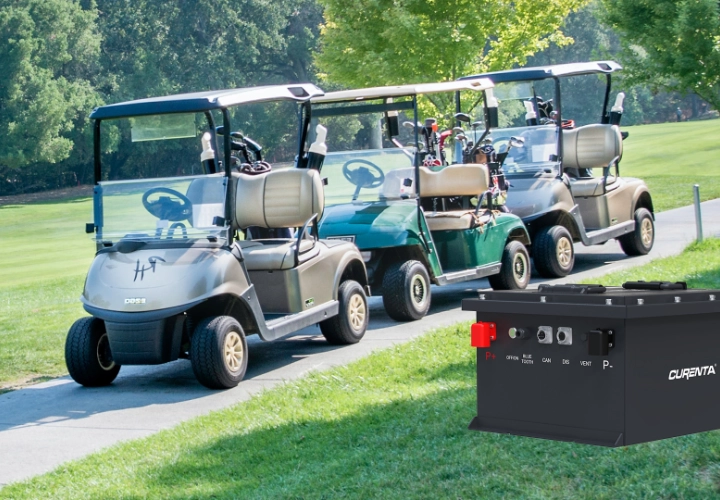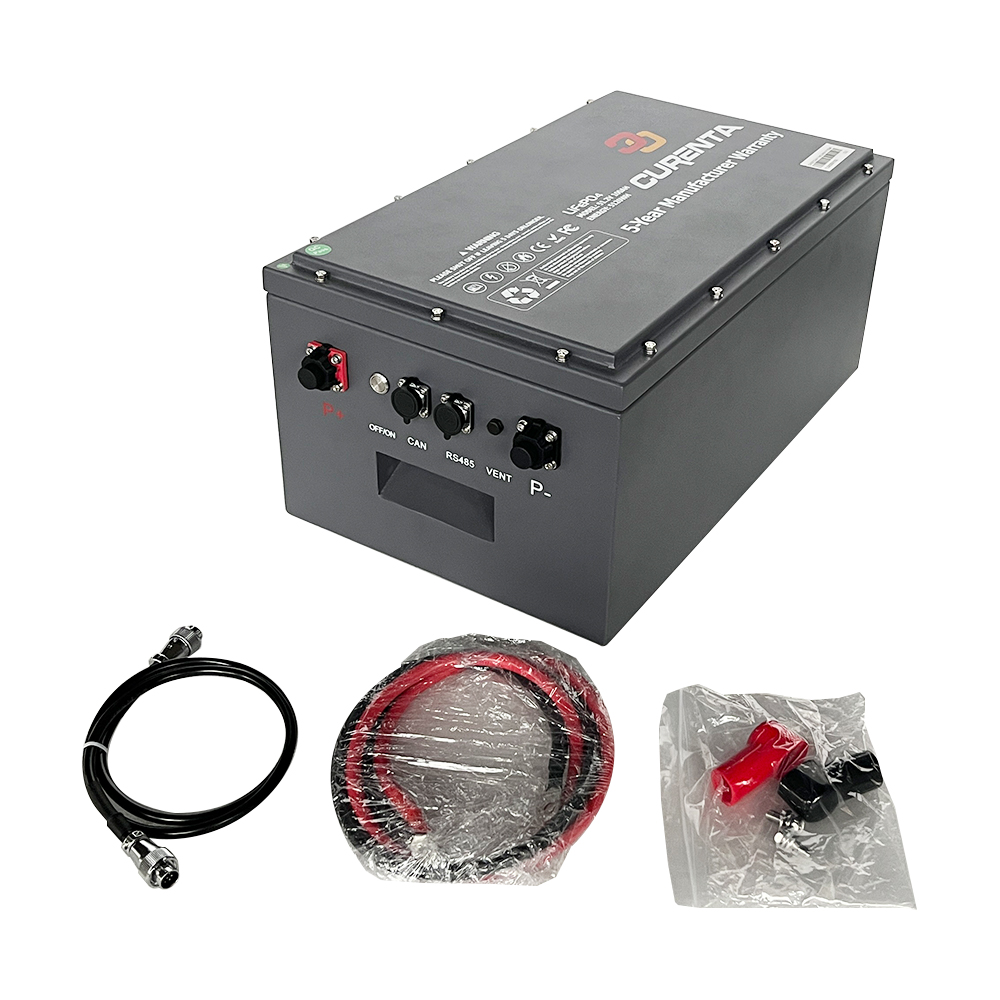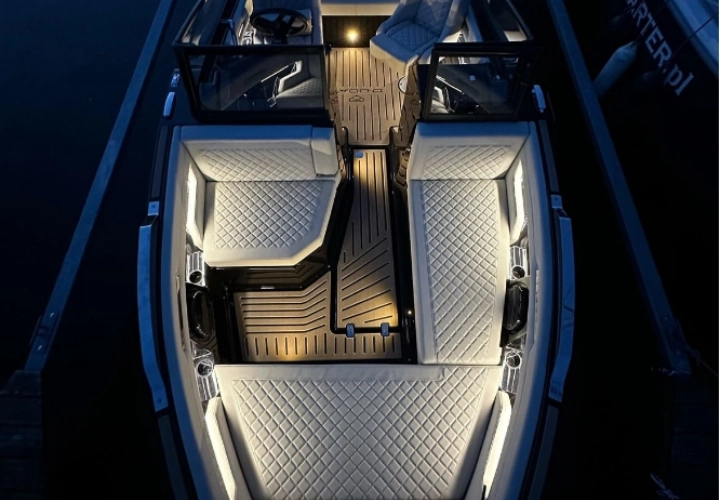Learn More >
Why Should You Consider a Marine LiFePO₄ Battery for Your Vessel?
Are you asking whether a marine LiFePO₄ battery could be the game-changer for your boat’s power system? At CURENTA BATTERY, we believe the answer is a definitive yes—and here’s why. In the evolving world of marine power, the shift to lithium iron phosphate (LiFePO₄) technology is more than a trend: it’s a meaningful upgrade in performance, reliability, safety and longevity for marine applications. This article will explore the benefits, considerations, and how a marine LiFePO₄ battery from CURENTA BATTERY can help you get ahead.
What is a Marine LiFePO₄ Battery?
Before diving into benefits, it helps to clarify what we mean by a marine LiFePO₄ battery. The term “marine” simply means the battery is designed for use on boats, yachts, work-vessels or other seafaring craft. “LiFePO₄” stands for lithium iron phosphate, which is a particular lithium-ion chemistry widely adopted for deep-cycle, energy-storage uses. In a marine context, a marine LiFePO₄ battery offers the deep-cycle capability, rugged construction, and environmental tolerance that boaters demand.
Here at CURENTA BATTERY, our marine LiFePO₄ batteries are built with marine-grade protections (such as robust enclosures, corrosion-resistant terminals, BMS (Battery Management System) tailored for marine use) and optimized for performance in a boating environment.
Key Advantages of Marine LiFePO₄ Batteries for Boats
Longer Life and More Cycles
One of the standout advantages of using a marine LiFePO₄ battery is its cycle life. Many LiFePO₄ systems are rated for thousands of cycles—often in the range of 2,000 to 5,000 or more—much higher than traditional lead-acid batteries.
For boaters, that means fewer battery replacements over the life of the vessel: less downtime, less hassle, and lower total cost of ownership.
Lighter Weight & More Efficient Usage
Weight is a critical factor in marine vessels. A lighter battery bank improves vessel performance, speed, and fuel efficiency. Marine LiFePO₄ batteries are significantly lighter than equivalent capacity lead-acid banks.
Moreover, because LiFePO₄ allows deeper discharge (more usable energy) compared to lead-acid, you effectively get more available power for the same or smaller footprint.
High Depth of Discharge (DoD) & Flat Voltage Curve
Marine LiFePO₄ batteries allow you to safely use a greater portion of their capacity—often 80 % or more—without accelerating degradation. Traditional lead-acid batteries may only safely use ~50 % of their capacity.
Also, LiFePO₄ chemistry maintains a near-flat voltage output during discharge, which means your on-board electronics, navigation systems and motors continue to perform effectively until the battery nears depletion.
Faster Charging, Better Efficiency
In marine operations where time matters (docking, prepping for departure, recharging from shore or solar), a marine LiFePO₄ battery excels. These batteries accept higher charge rates safely, meaning shorter downtime.
Better efficiency and lower self-discharge also mean your vessel is ready when you are.
Enhanced Safety & Environmental Benefits
Safety on the water is non-negotiable. LiFePO₄ chemistry is inherently more stable, less prone to thermal runaway, and better suited to the marine environment than many older chemistries.
From an environmental standpoint, LiFePO₄ batteries avoid heavy metals like lead or cadmium, are more recyclable, and produce less waste across their lifetime.
Why Choose CURENTA BATTERY’s Marine LiFePO₄ Solutions?
At CURENTA BATTERY, we understand the unique demands of the marine environment. Here are some of the reasons why our marine LiFePO₄ battery solutions stand out:
Marine-Grade Construction: Corrosion-resistant terminals and housings designed to withstand salt spray, humidity and vibration common on boats.
Optimized BMS: Our battery management systems are tuned for marine use—handling charging from alternators, solar panels, shore power, and ensuring safe operation in variable conditions.
Depth of Capacity: We size our batteries to give you usable capacity rather than just nominal rating—so you extract more useful power during your voyage.
Lifecycle Value: While the upfront cost is higher than lead-acid alternatives, our marine LiFePO₄ batteries from CURENTA deliver significantly lower total cost of ownership over their life thanks to extended cycle life and low maintenance.
Installation Support: We provide guidance on proper installation in marine environments: wiring, ventilation, charging system compatibility, and safety best-practices.
Where and How to Use a Marine LiFePO₄ Battery
Auxiliary Power Banks & House Systems
On many vessels the largest power draw comes from lighting, communications gear, navigation systems, refrigerators/freezers, and entertainment systems—often grouped under the “house bank.” A marine LiFePO₄ battery is ideal for such applications: high capacity, deep discharge, reliable voltage, and minimal maintenance.
Electric Propulsion & Trolling Motors
If you’re relying on an electric outboard or trolling motor, the demands on your battery bank are higher (high current draw, rapid discharge) and safety & weight considerations are even more critical. The marine LiFePO₄ battery handles these demands impressively.
Hybrid Systems: Solar + Shore Power Integration
Many boaters are equipping their vessels with solar panels, alternators, and shore-power chargers. A marine LiFePO₄ battery fits perfectly into this architecture—fast charging, minimal self-discharge, ideal for intermittent charging scenarios and reliable when you need it.
Off-Grid or Remote Voyages
When you’re away from shore power for long stretches, reliability becomes paramount. Because of the robustness of LiFePO₄ chemistry and the depth of usable capacity, your marine LiFePO₄ battery becomes a trusted partner for longer journeys, live-aboard situations, or remote anchorages.
What to Look Out For When Choosing Marine LiFePO₄ Batteries
While the benefits are compelling, there are critical considerations to ensure you get the most out of a marine LiFePO₄ battery.
Compatibility with Existing Systems
Voltage Match: Most marine systems are 12 V, 24 V or 48 V. Ensure the LiFePO₄ battery (or bank) matches your system.
Charging Sources: Alternator output, shore-charger profiles, solar controllers—make sure they are compatible with LiFePO₄ charging requirements. Some older lead-acid chargers may not suit LiFePO₄.
Wiring & Connections: High-current demands mean appropriately sized wiring, busbars, and terminals are needed to avoid voltage drop and excessive heating.
Thermal & Environmental Conditions
Marine installations expose batteries to salt spray, high humidity, vibration, possible immersion or splash, and wide temperature swings. Ensure your marine LiFePO₄ battery is rated for marine use, with proper enclosure ratings (IP65, IP67 etc) and thermal protections.
Also note: while LiFePO₄ handles temperature extremes better than many alternatives, very cold charging may require derating or a battery heater.
Depth of Discharge and Battery Sizing
Because LiFePO₄ allows deeper discharge safely, you might infer you can go with a smaller battery bank—but it’s wise to adequately size to ensure you aren’t regularly running near full depletion, which can shorten life. Also, consider future demands (electronics upgrades, more appliances).
Ensure your battery bank is configured with sufficient capacity to meet your usage pattern.
Quality of the BMS and Safety Features
The value of a marine LiFePO₄ battery is only as good as its management system. A good BMS monitors cell balance, temperature, voltage, current, protects against over-charge/over-discharge, and in marine use often includes features like Bluetooth monitoring, remote alarms, or integration with vessel monitoring systems.
Total Cost of Ownership
Although marine LiFePO₄ batteries cost more upfront than lead-acid, if you consider the lifecycle (fewer replacements, reduced maintenance, fuel savings via weight reduction, better usable capacity) the overall value becomes very compelling.
Frequently Asked Questions About Marine LiFePO₄ Batteries
Q: How much longer will a marine LiFePO₄ battery last compared to lead-acid?
A: Many LiFePO₄ batteries provide thousands of cycles (2,000–5,000+), whereas typical lead-acid banks deliver a few hundred cycles before significant degradation.
That means you may replace a lead-acid bank every 3–5 years in heavy use, whereas a well-managed LiFePO₄ bank could serve 10 years or more.
Q: Can I use my existing charger and alternator for a marine LiFePO₄ battery?
A: It depends. Some older chargers / alternators are configured for lead-acid profiles and may not provide optimal charging for LiFePO₄. It’s very important to check charger voltage and algorithm compatibility, or select a charger/bank that supports LiFePO₄. You may need to update some components.
Q: Are marine LiFePO₄ batteries safe on a boat?
A: Yes—LiFePO₄ chemistry is considered one of the safest lithium technologies, offering strong thermal stability and resistance to runaway scenarios. That said, proper installation, marine-rated enclosure, ventilation (if installing inside a compartment), and marine-certified BMS are still essential.
Q: What’s the payback period for upgrading to a marine LiFePO₄ battery?
A: The payback depends on your usage. If you frequently discharge your battery deeply, use a lot of capacity, or replace batteries often, the long life and high usable capacity of LiFePO₄ means you’ll see value relatively quickly. For light usage, benefits are still there—but the payback may be spread out over a longer timeframe.
Q: Can I scale a marine LiFePO₄ battery bank if I add more loads later?
A: Yes. Lithium systems are very modular. You can add additional modules or parallel banks—provided the BMS and wiring are configured accordingly—and manage the expansion with CURENTA BATTERY’s guidance to maintain balanced performance.
Real-Life Scenario: Upgrading Your Boat with CURENTA BATTERY’s Marine LiFePO₄ Solution
Let’s imagine you own a 30-foot cruising sailboat. You currently have a 400 Ah lead-acid house bank that you regularly discharge to ~50 % on weekend trips. You’re planning extended cruises and expect to run fridge, navigation, autopilot, lighting, inverts and a trolling motor for longer periods.
Step 1: Define Your Usable Energy Needs
If your current lead-acid bank is 400 Ah at 12 V, but discharge is limited to 50 % safe use, you effectively get 200 Ah usable. If you plan to upgrade loads (e.g., fridge upgrade, electronics expansion), you might need 300–350 Ah usable.
Step 2: Select a Marine LiFePO₄ Battery Bank
With LiFePO₄, you can safely use 80-90 % of rated capacity. So a 300 Ah usable requirement might correspond to ~330-400 Ah rated capacity. At CURENTA BATTERY, we might specify a 12 V/400 Ah LiFePO₄ battery bank, giving ~320–350 Ah usable with margin.
Step 3: Determine Weight/Volume Savings
Compared to your lead-acid bank (which may weigh ~500 lbs or more for 400 Ah), the LiFePO₄ might weigh 50-60 % less (say ~220–250 lbs). That’s significant weight savings, improved balance, better speed and fuel economy under power.
Step 4: Charging System Compatibility
Ensure your alternator and charger are set up for LiFePO₄ charging profiles—voltage limits, absorption times, etc. At CURENTA BATTERY, we assist with verifying compatibility or recommending appropriate charger upgrades.
Step 5: Installation & Integration
Install the new bank in the boat, ensure cables are sized correctly, a fuse or circuit breaker is placed near the battery, ensure ventilation (though LiFePO₄ generates less gas than lead-acid), and mount the BMS or monitoring system.
Step 6: Monitor and Optimize
Once in service, you’ll notice the flatter voltage during discharge (gear runs longer at full power), shorter recharge times after arrivals, and less concern about deep-discharge cycles. Over time, you’ll benefit from reduced replacement cost, already offset against the original extra investment.
Common Myths and Misconceptions about Marine LiFePO₄ Batteries
Myth: “LiFePO₄ is more dangerous than lead-acid.”
Reality: LiFePO₄ is among the safest lithium chemistries available, with excellent thermal stability and resistance to thermal runaway. With proper BMS and marine-rated installation, it is at least as safe as lead-acid and offers many safety advantages.
Myth: “Lead-acid is cheaper so it’s always better for boats.”
Reality: While the upfront cost of lead-acid is lower, when you factor in shorter lifespan, less usable capacity, heavier weight (which impacts fuel/propulsion efficiency), more frequent replacements and maintenance—you’ll often find that marine LiFePO₄ batteries have a lower total cost of ownership.
Myth: “Lithium batteries require a lot of maintenance.”
Reality: Quite the opposite. LiFePO₄ batteries are virtually maintenance-free compared to flooded lead-acid (no watering, minimal terminal corrosion issues) and benefit from long life.
Myth: “If my charger isn’t designed for LiFePO₄ I’m stuck.”
Reality: There are many marine chargers and alternator regulators now designed to support LiFePO₄ profiles. With proper wiring and settings, upgrading to a marine LiFePO₄ bank from CURENTA BATTERY is fully feasible.
Making the Transition: Practical Steps when Switching to Marine LiFePO₄
Audit your current power system: Understand your loads, usage pattern, discharge depth, charging sources, and any weak links (aging alternator, under-sized charger, poor wiring).
Choose your LiFePO₄ bank size: Based on usable energy needs, future growth, battery compartment space, ventilation, weight and wiring layout.
Ensure charging system compatibility: Alternator, charger, solar controller—all should support or be set for LiFePO₄. Consider upgrading regulators if needed.
Plan wiring/installation carefully: Proper cable gauge, busbars, fusing, BMS location, ventilation, avoiding corrosion, securing battery for marine shock/vibration.
Install monitoring & safety systems: CURENTA BATTERY’s marine LiFePO₄ banks include robust BMS; integrate battery monitor/display to observe state of charge, temperature, voltage.
Test & commission: Before heading out on a long trip, test the system under load (motors, fridge, autopilot) and observe how the bank behaves, how charging works, and how the vessel performs.
Enjoy the benefits: Lighter weight, more usable capacity, faster recharge, less worry about battery end-of-life, longer system life—and more time enjoying the water.
Conclusion: Is a Marine LiFePO₄ Battery from CURENTA the Right Move?
If you’re serious about marine performance, reliability and future-proofing your vessel’s power system, then upgrading to a marine LiFePO₄ battery is a smart decision—and one that CURENTA BATTERY is here to enable. With its superior lifespan, high usable capacity, lighter weight, faster recharge and enhanced safety, a marine LiFePO₄ battery addresses many of the traditional constraints of marine power systems.
Of course, the value you receive depends on how you use your boat, how the system is sized and installed, and how your charging sources support the bank. But in almost any scenario where you’re moving beyond basic, occasional usage, the leap from lead-acid to a marine LiFePO₄ bank is one of the most impactful upgrades you can make.
Feel free to reach out to CURENTA BATTERY for a personalized assessment: we’ll help you evaluate your current system, estimate your energy usage, and recommend the right marine LiFePO₄ battery solution to match your vessel and boating goals.

 English
English German
German Czech
Czech French
French Italian
Italian Hungarian
Hungarian Russian
Russian Japanese
Japanese Korean
Korean Arabic
Arabic Spanish
Spanish Portuguese
Portuguese Danish
Danish


 WhatsApp
WhatsApp